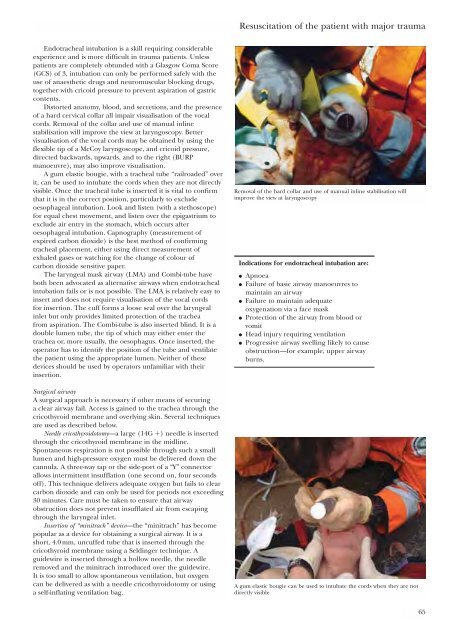RESUSCITATION
RESUSCITATION
RESUSCITATION
You also want an ePaper? Increase the reach of your titles
YUMPU automatically turns print PDFs into web optimized ePapers that Google loves.
Resuscitation of the patient with major trauma<br />
Endotracheal intubation is a skill requiring considerable<br />
experience and is more difficult in trauma patients. Unless<br />
patients are completely obtunded with a Glasgow Coma Score<br />
(GCS) of 3, intubation can only be performed safely with the<br />
use of anaesthetic drugs and neuromuscular blocking drugs,<br />
together with cricoid pressure to prevent aspiration of gastric<br />
contents.<br />
Distorted anatomy, blood, and secretions, and the presence<br />
of a hard cervical collar all impair visualisation of the vocal<br />
cords. Removal of the collar and use of manual inline<br />
stabilisation will improve the view at laryngoscopy. Better<br />
visualisation of the vocal cords may be obtained by using the<br />
flexible tip of a McCoy laryngoscope, and cricoid pressure,<br />
directed backwards, upwards, and to the right (BURP<br />
manoeuvre), may also improve visualisation.<br />
A gum elastic bougie, with a tracheal tube “railroaded” over<br />
it, can be used to intubate the cords when they are not directly<br />
visible. Once the tracheal tube is inserted it is vital to confirm<br />
that it is in the correct position, particularly to exclude<br />
oesophageal intubation. Look and listen (with a stethoscope)<br />
for equal chest movement, and listen over the epigastrium to<br />
exclude air entry in the stomach, which occurs after<br />
oesophageal intubation. Capnography (measurement of<br />
expired carbon dioxide) is the best method of confirming<br />
tracheal placement, either using direct measurement of<br />
exhaled gases or watching for the change of colour of<br />
carbon dioxide sensitive paper.<br />
The laryngeal mask airway (LMA) and Combi-tube have<br />
both been advocated as alternative airways when endotracheal<br />
intubation fails or is not possible. The LMA is relatively easy to<br />
insert and does not require visualisation of the vocal cords<br />
for insertion. The cuff forms a loose seal over the laryngeal<br />
inlet but only provides limited protection of the trachea<br />
from aspiration. The Combi-tube is also inserted blind. It is a<br />
double lumen tube, the tip of which may either enter the<br />
trachea or, more usually, the oesophagus. Once inserted, the<br />
operator has to identify the position of the tube and ventilate<br />
the patient using the appropriate lumen. Neither of these<br />
devices should be used by operators unfamiliar with their<br />
insertion.<br />
Surgical airway<br />
A surgical approach is necessary if other means of securing<br />
a clear airway fail. Access is gained to the trachea through the<br />
cricothyroid membrane and overlying skin. Several techniques<br />
are used as described below.<br />
Needle cricothyroidotomy—a large (14G ) needle is inserted<br />
through the cricothyroid membrane in the midline.<br />
Spontaneous respiration is not possible through such a small<br />
lumen and high-pressure oxygen must be delivered down the<br />
cannula. A three-way tap or the side-port of a “Y” connector<br />
allows intermittent insufflation (one second on, four seconds<br />
off). This technique delivers adequate oxygen but fails to clear<br />
carbon dioxide and can only be used for periods not exceeding<br />
30 minutes. Care must be taken to ensure that airway<br />
obstruction does not prevent insufflated air from escaping<br />
through the laryngeal inlet.<br />
Insertion of “minitrach” device—the “minitrach” has become<br />
popular as a device for obtaining a surgical airway. It is a<br />
short, 4.0 mm, uncuffed tube that is inserted through the<br />
cricothyroid membrane using a Seldinger technique. A<br />
guidewire is inserted through a hollow needle, the needle<br />
removed and the minitrach introduced over the guidewire.<br />
It is too small to allow spontaneous ventilation, but oxygen<br />
can be delivered as with a needle cricothyroidotomy or using<br />
a self-inflating ventilation bag.<br />
Removal of the hard collar and use of manual inline stabilisation will<br />
improve the view at laryngoscopy<br />
Indications for endotracheal intubation are:<br />
●<br />
●<br />
●<br />
●<br />
●<br />
●<br />
Apnoea<br />
Failure of basic airway manoeuvres to<br />
maintain an airway<br />
Failure to maintain adequate<br />
oxygenation via a face mask<br />
Protection of the airway from blood or<br />
vomit<br />
Head injury requiring ventilation<br />
Progressive airway swelling likely to cause<br />
obstruction—for example, upper airway<br />
burns.<br />
A gum elastic bougie can be used to intubate the cords when they are not<br />
directly visible<br />
65

















